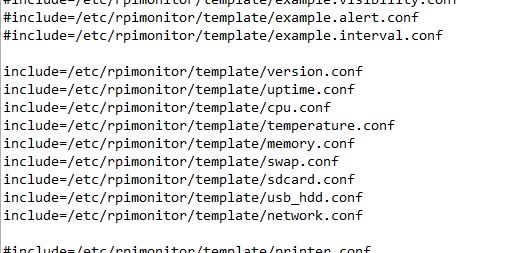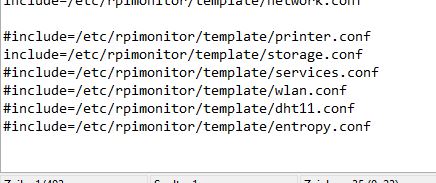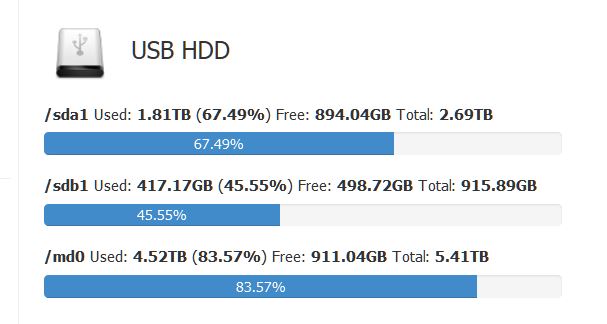I think that it’d be great if you could add a USB HDD monitor to RPi Monitor, like so:
When installing RPiMonitor, check to see if a USB hard drive is being used for storage, then add the line include=/etc/rpimonitor/template/usb_hdd.conf after the line for sdcard.conf (scroll to the bottom):
########################################################################
#
# KPI extraction configuration
#
# This part of the configuration file is defining which data to
# extract how to extract them and when.
#
# Specific 'include' keyword is available to add a file at the end of
# the list of configuration files to be loaded.
#
# include=<full path to configuration file>
# <full path to configuration file> is the full path to the
# configuration file to add at the end of the list of configuration
# files to be loaded.
#
# Static KPI are extracted once at rpimonitord startup. Each statistic
# is identified into the conf file by a line stating with the keyword
# static and an identifier <static data id>
#
# Each static KPI is defined by an id and with 4 parameters
#
# static.<static data id>.name=<data name>
# <data name> is a string representing the KPI or the list of KPI
# separated by comma. Each name has to be unique.
# Only alpha numerical charter and underscore are accepted.
#
# static.<static data id>.source=<data source>
# <data source> is a file or an executable file within the path.
# If the file exists, rpimonitord will read its content. If the file
# is not existing, rpimonirotd will try to execute it and will parse
# the output.
# Warning: specifying an executable by its absolute name will tell
# rpimonitord to read the content of the executable.1.graph.
#
# static.<static data id>.regexp=<data regexp>
# <data regexp> is the regular expression extracting information from
# data source. Regexp groups () has to be used to extract the data
# In case of KPI list, each group will be affected to a KPI name.
#
# static.<static data id>.postprocess=<data postprocess>
# <data postprocess> is an expression defining the postprocessing to
# be applied on result. KPI are idendified by $1. In case of list,
# other KPI are identified by $2, $3 .graph..
# This parameter will be evaluate by the command eval of perl.
#
# Dynamic KPI are extracted periodically (defined by daemon.delay)
# Each statistic is identified into the conf file by a line stating
# with the keyword dynamic and an identifier <dynamic data id>
#
# Each dynamic KPI is defined by an id and with 5 parameters
#
# dynamic.<dynamic data id>.name=<data name>
# dynamic.<dynamic data id>.source=<data source>
# dynamic.<dynamic data id>.regexp=<data regexp>
# dynamic.<dynamic data id>.postprocess=<data postprocess>
# <data name>, <data source>, <data regexp>, <data postprocess>
# This 4 first parameters have the same signification as for static
# parameters.
#
# dynamic.<dynamic data id>.rrd=<|GAUGE|COUNTER|DERIVE|ABSOLUTE|COMPUTE>
# The 5th parameter is defining if the KPI has to be stored into a RRD
# database and how <|GAUGE|COUNTER|DERIVE|ABSOLUTE|COMPUTE>. If the
# parameter is defined as empty, no RRD database will be created. If
# this parameter is defined, a RRD database will be created and data
# will be stored at every extraction.
# Ref http://oss.oetiker.ch/rrdtool/doc/rrdcreate.en.html for RRD
# parameter description.
# dynamic.<dynamic data id>.min=<minimal value acceptable in RRD>
# dynamic.<dynamic data id>.max=<miximal value acceptable in RRD>
# If a value extracted by is less than minimal of greater than maximal
# value, it will be stored int RRD database as unknown.
# These limits are usefull to handle counter that fall down to 0 when
# they reach their limit (Ex: network graphs)
#
# Note: Static values are accessible for the post processing using the
# variable $this->{'static'}->{'static_data_name'} and can be used.
# You can refer to swap data extraction to see an example.
#
########################################################################
#
# Web interface configuration
#
# Friends are defining a displayed name and a link reachable from a
# top left menu visible if at least one friends is configured. Each
# friend is identified by its <id> and is described by the 2 following
# parameters
#
# web.friends.<id>.name=<display name>
# web.friends.<id>.link=<link to RPi-Monitor>
#
# web.friends.<id>.name=<display name>
# <display name> is the name printed into the drop down menu
#
# web.friends.<id>.link=<link to RPi-Monitor>
# <link to RPi-Monitor> is the link to another RPi-Monitor running
# into the friend machine.
#
# web.page.icon=<icon location relative to webroot>
# <icon location relative to webroot> is the path and filename of
# the icon to be displayed into RPi-Monitor title bar
#
# web.page.menutitle=<menu title>
# <menu title> javascript code defining the text displayed into
# RPi-Monotor title bar. This code can use status information with
# the keyword 'data' including the 'data.hostname' available natively
#
# web.page.pagetitle=<page title>
# <page title> javascript code defining the text displayed into
# tab and window title bar. This code can use status information with
# the keyword 'data' including the 'data.hostname' available natively
#
# The status page is fully configurable.
# It is possible to define multiple pages. Each page is identified by
# its <page id>.
#
# web.status.<page id>.name=<page name>
# <page name> name of the page displayed into the drop down menu in
# case of multiple pages.
#
# Status page is split in strips displaying information. Each status
# strip is identified by a unique <status id>. Each status strip is
# defined by a name, an icon and a serie of lines described as follow:
#
# web.status.<page id>.visibility=<visibility formula>
#
# <visibility forlula> should be a valid javascript formula returning
# 0: to hide the row
# anything else but 0: show the row
#
# web.status.<page id>.content.<status id>.name=<display name>
# web.status.<page id>.content.<status id>.icon=<display icon>
# web.status.<page id>.content.<status id>.line.<line number>=<parameter>
#
# web.status.<page id>.content.<status id>.name=<display name>
# <display name> Name displayed as title of the strip
#
# web.status.<page id>.content.<status id>.icon=<display icon>
# <display icon> Icon of the strip
#
# web.status.<page id>.content.<status id>.line.<line number>=<parameter>
# <line number> represent the position of the line within the strip.
# This number has to be unique within the strip.
# <parameter> is describing the content of the line. This parameter
# will be evaluated by the javascript command with the function
# eval() theirfore parameter should be valid javacript.
# To have clean rendering, RPi-Monitor web interface provides some
# functions that could be used inside the parameter. The object data
# is also available and contains the result of dynamic and static
# extracted as described in the KPI extraction section.
#
# Functions provided by RPi-Monitor are the following:
#
# Uptime(uptime in sec)
# Print the uptime from seconds to the following format:
# XX year XX days XX hours XX minutes XX seconds
#
# Pad(value)
# Add a prefixed 0 for number smaller than 10
#
# KMG(value, pre)
# Print value in kilo, Mega, Giga, Peta.
# pre can be 'k', 'M', 'G' or 'P' depending on the value.
#
# Percent(value,total)
# Print percentage of value compared to total
#
# ProgressBar(value,total,warning, danger)
# Draw a progressbar representing the value compared to total.
# [=========------------]
# The default color of pregressbar is blue.
# If warning value is lower than critical, progressbar color will
# be orange if percentage is higher than warning value and red
# if the percentage is higher than danger value
# If warning value is higher than critical, progressbar color will
# be orange if percentage is lower than warning value and red
# if the percentage is lower than danger value
#
# GageBar(title, label,min, value, max, width, height, levelColors, warning, critical)
# Draw a half-circular gauge
# title : Title of the gauge (located on to of the gauge)
# label : Label of the gauge (located under the value)
# min : min value of the gauge
# value : value to be drawn
# max : max value of the gauge
# width, height : size of the gauge
# levelColors : Array defining colors of each level [normal,warning,critical]
# (in Hex format), default: green, orange and red.
# Default colors are available into the array 'percentColors'.
# warning : Warning level (in %) used to define color (default: 33)
# critical : Critical level (in %) used to define color (default: 66)
#
# Plural (value)
# Print 's ' if value > 1 or ' ' if not.
#
# Clock(data.localtime)
# This function is a little bit particular and should be written
# and should be written exactly as in the upper line. It will
# display on screen the current time and will simulate the
# seconds by incrementing them periodically.
#
# Label(data,formula, text, level)
# Badge(data,formula, text, level)
# This function will write a label/badge with a defined
# background color if the formula return TRUE.
# data : data to use with the formula
# formula : formula evaluated in regards to data to determine
# if label/badge has to be printed
# text : text to be displayed
# level : 'default' (grey), 'primary' (blue label/grey badge),
# 'success' (green), 'info' (cyan), 'warning' (orange)
# or 'danger' (red)
#
# InsertHTML(url)
# This function is used to insert an HTML information inside
# a page. (Ref Top3 example showing top most process cpu usage)
#
# The statistic page is fully configurable.
# It is possible to define multiple pages. Each page is identified by
# its <page id>.
#
# web.status.<page id>.name=<page name>
# <page name> name of the page displayed into the drop down menu in
# case of multiple pages.
#
# The statistic page displays statistics graphs. The graphs are
# identified an unique <statistic id> and by the following parameters.
#
# web.statistics.<page id>.content.<statistic id>.name=<statistic name>
# <statistic name> is the name of the statistics displayed in the
# top left drop down list.
#
# web.statistics.<page id>.content.<statistic id>.graph.<rrd id>=<data name>
# <rrd id> is identifying the graph and is unique per <statistic id>
# <data name> is the name of the dynamic and static extracted as
# described in the KPI extraction section.
#
# web.statistics.<page id>.content.<statistic id>.ds_graph_options.<data name>.label=<label>
# <data name> same as the previous <data name>
# <label> Label to display in legends. It is possible to setup other parameters
# of ds_graph_options. Refer to the following web page for details:
# http://javascriptrrd.sourceforge.net/docs/javascriptrrd_v0.5.0/doc/lib/rrdFlot_js.html
#
# web.statistics.<page id>.content.<statistic id>.graph_options.<parameter>=<value>
# <parameter> and <value> can be find into the same web page as previous
# parameter. This allow to customize the graph and axis.
#
# Example file are available in the template directory (prefixed by 'example').
# To understand how a feature is behaving, you can include this example file
# using the 'include' directive.
# These include directive are already written (commented) into the default
# configuration file: raspbian.conf
# When configuration files change, it is required to restart rpimonitor.
#######################################################################
#web.friends.1.name=Raspberry Pi
#web.friends.1.link=http://192.168.0.123/
#web.friends.2.name=Shuttle
#web.friends.2.link=http://192.168.0.2/
#web.friends.3.name=Netbook
#web.friends.3.link=http://192.168.0.38/
web.page.icon='img/logo.png'
web.page.menutitle='RPi-Monitor <sub>('+data.hostname+')</sub>'
web.page.pagetitle='RPi-Monitor ('+data.hostname+')'
web.status.1.name=Raspberry Pi
#web.status.2.name=Home
web.statistics.1.name=Raspberry Pi
#web.statistics.2.name=page 2
web.addons.1.name=Addons
web.addons.1.addons=about
#web.addons.1.name=Shellinabox
#web.addons.1.addons=shellinabox
#web.addons.2.name=Addons example
#web.addons.2.addons=example
#web.addons.2.showTitle=0
#web.addons.3.name=Webcam - Hawkeye
#web.addons.3.showTitle=0
#web.addons.3.addons=custom
#web.addons.3.url=http://0:8000/
#web.addons.4.name=Custom addons
#web.addons.4.addons=custom
#web.addons.4.showTitle=0
#web.addons.4.url=/addons/custom/custominfo.html
#web.addons.5.name=Top3
#web.addons.5.addons=top3
#include=/etc/rpimonitor/template/example.justgage.conf
#include=/etc/rpimonitor/template/example.badge_and_label.conf
#include=/etc/rpimonitor/template/example.progressbar.conf
#include=/etc/rpimonitor/template/example.visibility.conf
include=/etc/rpimonitor/template/version.conf
include=/etc/rpimonitor/template/uptime.conf
include=/etc/rpimonitor/template/cpu.conf
include=/etc/rpimonitor/template/temperature.conf
include=/etc/rpimonitor/template/memory.conf
include=/etc/rpimonitor/template/swap.conf
include=/etc/rpimonitor/template/sdcard.conf
include=/etc/rpimonitor/template/usb_hdd.conf
include=/etc/rpimonitor/template/network.conf
#include=/etc/rpimonitor/template/printer.conf
#include=/etc/rpimonitor/template/storage.conf
#include=/etc/rpimonitor/template/services.conf
#include=/etc/rpimonitor/template/wlan.conf
#include=/etc/rpimonitor/template/dht11.conf
Then copy the file /etc/rpimonitor/template/usb_hdd.conf:
########################################################################
# Extract USB HDD (sda1) information
# Page: 1
# Information Status Statistics
# - USBHDD1 total - yes - yes
# - USBHDD1 used - yes - yes
########################################################################
static.10.name=usbhdd_total
static.10.source=df -t ext4
static.10.regexp=sda1\s+(\d+)
static.10.postprocess=$1/1024
dynamic.14.name=usbhdd_used
dynamic.14.source=df -t ext4
dynamic.14.regexp=sda1\s+\d+\s+(\d+)
dynamic.14.postprocess=$1/1024
dynamic.14.rrd=GAUGE
web.status.1.content.9.name=USB HDD
web.status.1.content.9.icon=usb_hdd.png
web.status.1.content.9.line.1="<b>/sda1</b> Used: <b>"+KMG(data.usbhdd_used,'M')+"</b> (<b>"+Percent(data.udbhdd_used,data.usbhdd_total,'M')+"</b>) Free: <b>"+KMG(data.usbhdd_total-data.usbhdd_used,'M')+ "</b> Total: <b>"+ KMG(data.usbhdd_total,'M') +"</b>"
web.status.1.content.9.line.2=ProgressBar(data.usbhdd_used,data.usbhdd_total)
web.statistics.1.content.9.name=USB HDD
web.statistics.1.content.9.graph.1=usbhdd_total
web.statistics.1.content.9.graph.2=usbhdd_used
web.statistics.1.content.9.ds_graph_options.usbhdd_total.label=USB HDD total space (MB)
web.statistics.1.content.9.ds_graph_options.usbhdd_total.color="#FF7777"
web.statistics.1.content.9.ds_graph_options.usbhdd_used.label=USB HDD used space (MB)
web.statistics.1.content.9.ds_graph_options.usbhdd_used.lines={ fill: true }
web.statistics.1.content.9.ds_graph_options.usbhdd_used.color="#7777FF"
Note: I simply used the storage.conf file as a template, so the content numbers (static.10, dynamic.14, etc.) might need changing, but as you can see from the screenshot, it all seems to work fine.
Thanks,
Rich.



